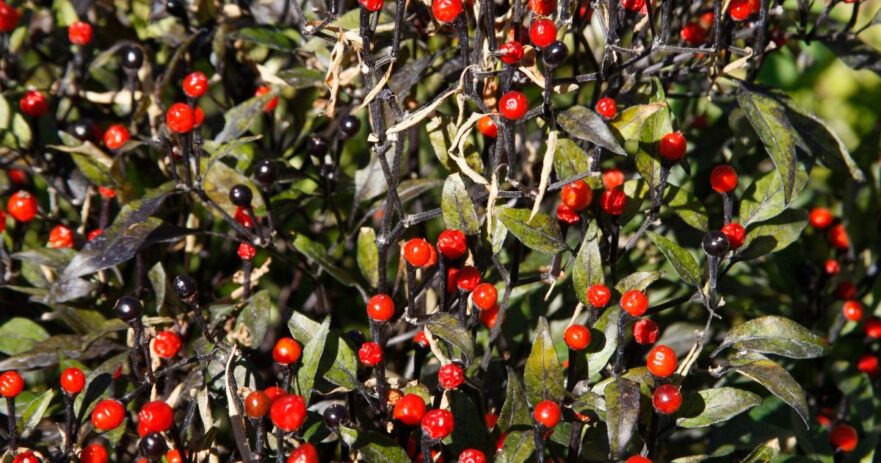In this article about chiltepin pepper:
🗺️ Origin and history | 🌶️ Uses | ✨ Appearance and taste | 🧑🌾 Growing – gardening | 👨🍳 Cooking – recipes | 🛒 Where to buy | 🫙 How to store | 👨⚕️ Health benefits | 🌶️ Alternatives and substitutes | ❓ Frequently asked questions
What is a Chiltepin pepper?
Chiltepin peppers, often called „the mother of all peppers,“ are revered for their extreme heat and unique flavor. Originating from Mexico and the southern United States, these tiny, round, or slightly oval peppers pack a fiery punch that exceeds their diminutive size.
Chiltepin peppers have a complex flavor with smoky, nutty, and earthy undertones. Used sparingly, they add significant depth to Mexican, Southwestern, and other cuisines. Additionally, Chiltepin peppers bring heat and flavor to various dishes, from salsas and sauces to soups and stews.
| Chiltepin pepper | |
| SHU | 50,000 - 100,000 |
| Median SHU | 75,000 |
| Flavor | Smoky, earthy, and quite hot |
| Species | Capsicum annuum |
| Origin | Mexico, Southern United States |
| Uses | Salsas, sauces, as a seasoning, and as a pickling |
Are Chiltepin peppers spicy? How hot are they?
Chiltepin pepper scoville rating: 50,000 to 100,000 SHU
Chiltepin peppers are renowned for their spiciness. They hold a powerful position in the pepper heat scale, with a Scoville rating spanning 50,000 to 100,000 units. This positions the Chiltepin above jalapenos, which range from 2,500 to 8,000 Scoville units, but below the fiery habanero, which starts at 100,000 units.
The Chiltepin’s heat is distinctive in its rapid onset and swift fade, often described as a ‘quick flash’ of intense heat. It’s a pepper for those who appreciate robust spiciness and unique flavors. Remember that the heat can fluctuate due to environmental factors and maturity; more mature peppers are usually hotter.
🗺️ ORIGIN AND HISTORY
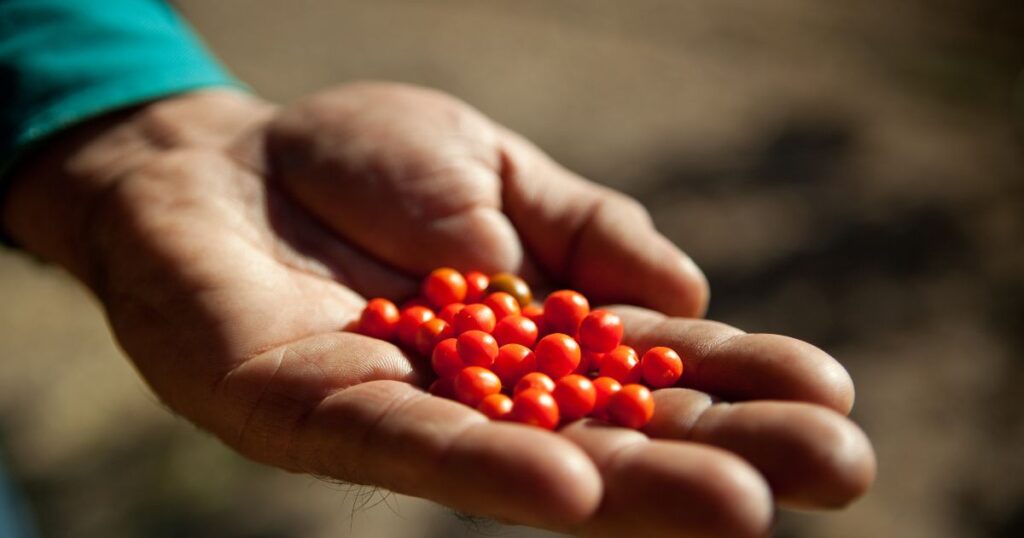
Where do Chiltepin peppers come from?
Chiltepin peppers trace their roots back to the southern United States and northern Mexico. These fiery chili peppers have been part of local culinary traditions for centuries, revered by indigenous communities long before the arrival of Europeans. As a result, the Chiltepin pepper has played a significant role in the area’s food and culture, providing flavor and medicinal value.
Today, Chiltepin peppers are grown in Mexico and parts of the American Southwest, including Texas and Arizona. Despite their small size, their intense heat and distinct taste have significantly impacted the culinary world, spicing up dishes across cultures.
🌶️ USES
What are Chiltepin peppers good for? How are they used?
Chiltepin peppers are incredibly adaptable and lend intense heat and distinctive flavor to various culinary applications. These small but fiery peppers can be used fresh or dried, with usage spanning from hot sauces and seasonings to cocktail garnishes and pickled delights.
Pickled chiltepin peppers are popular for harnessing their powerful heat and robust flavor. They can be added to sandwiches, served alongside a cheeseboard, or used as a garnish to add a kick. The pickling process also slightly tempers the chiltepin’s natural heat without overshadowing its unique flavor.
Additionally, chiltepin pepper sauce is an excellent addition to the kitchen, bringing an explosive burst of heat to dishes. This sauce works exceptionally well as a condiment for tacos, pizzas, and other dishes, turning an ordinary meal into a spicy delight.
Making chiltepin pepper powder is another way to use these fiery peppers. Dried and ground chiltepins provide an intense heat that can be sprinkled on virtually any dish, from roasted vegetables to grilled meats. Additionally, the heat can be controlled by the amount of powder used, allowing for the customization of spiciness to suit taste preferences.
A chiltepin pepper cocktail is an unconventional but exciting way to use these peppers. The peppers can be infused into a cocktail to add a surprising, spicy twist. This fiery beverage will create a memorable experience, appealing to those with a penchant for spice and adventure.
Finally, chiltepin peppers can create a unique and spicy salsa, providing a flavorful accompaniment to chips or a topping for your favorite dishes. The chiltepin peppers’ heat works well with the tomatoes’ acidity, creating a balanced, fiery, and satisfying salsa. Whether you’re an experienced spice-lover or looking to heat things up in the kitchen, chiltepin peppers are an excellent choice.
✨ APPEARANCE AND TASTE
What do Chiltepin peppers look like?
Chiltepin peppers are small, round, slightly oval-shaped chili peppers with a smooth or slightly wrinkled surface. They are about a quarter-inch to half an inch in diameter. The chiltepin pepper’s characteristic appearance, tiny size, and vivid coloration distinguish it from other varieties. When dried, chiltepins take on a rich, dark red, or burgundy color.
What does Chiltepin pepper taste like?
The taste of chiltepin peppers combines fiery heat and subtle, smoky undertones. Upon the first bite, the flavor is mild, with an almost earthy, smoky note. However, the spiciness intensifies with subsequent bites, producing a robust, searing heat that lingers on the palate.
Despite their high Scoville rating, chiltepin peppers are also appreciated for their complexity of flavors. Beyond their heat, they deliver a smoky, nutty taste that adds depth to their overall flavor. This distinct and appealing blend of tastes makes chiltepin peppers a favorite choice among chili enthusiasts and those seeking to spice up culinary creations.
🧑🌾 GROWING – GARDENING
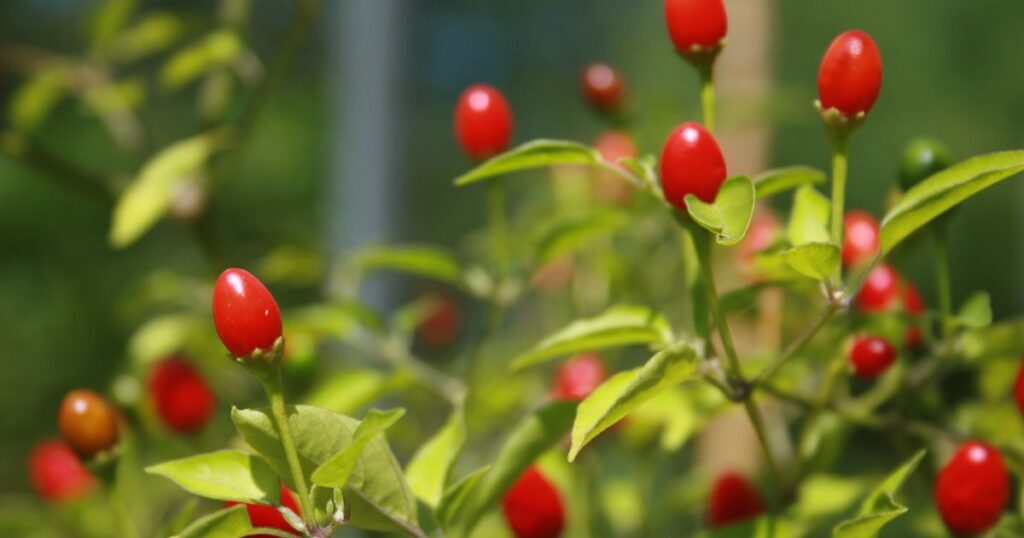
How to grow Chiltepin Peppers?
Chiltepin peppers offer a distinctive and rewarding challenge for gardening enthusiasts. They flourish in sunny, warm environments and can be cultivated in the ground and pots. Properly prepared, well-draining soil is crucial for successful growth; regular watering keeps the plants healthy and productive. Periodically adding a suitable fertilizer can enhance plants’ health and yield.
When to pick Chiltepin Peppers?
Chiltepin peppers take 100-120 days to reach full maturity, although the length can vary based on specific growing conditions. Regular harvesting encourages further fruit production and keeps the plant active as the peppers mature.
Though these peppers may take longer to mature than other varieties, the excitement of growing fiery chiltepin peppers makes the endeavor worthwhile. Gardeners and spice enthusiasts alike will appreciate the experience of cultivating and harvesting these exceptional little peppers.
👨🍳 COOKING – RECIPES
Cooking / Recipe ideas for Chiltepin Pepper
Chiltepin peppers’ distinctive, fiery flavor brings depth to various culinary creations. One common use is in crafting a zesty chiltepin pepper hot sauce. Blend peppers with onions, garlic, vinegar, and honey or sugar. The resulting sauce can elevate the flavor and spiciness of many dishes, including tacos, eggs, and grilled meats.
Chiltepin pepper salsa is another delightful use of these fiery chili peppers. A blend of tomatoes, onions, cilantro, and chiltepin peppers yields a bold, spicy salsa, ideal for tortilla chips or a topping on your favorite Mexican meals. The spiciness of the chiltepin peppers is beautifully balanced by the acidity of the tomatoes, creating a salsa bursting with authentic flavors.
A unique use of these peppers is in creating a chiltepin pepper cocktail, adding a spicy twist to drinks. Muddle a few chiltepin peppers at the bottom of your cocktail shaker, add your preferred spirits and mixers, and enjoy a beverage that’s not only refreshing but also offers a kick.
Making chiltepin pepper powder is another way to utilize these peppers in your kitchen. Dried and ground chiltepin peppers provide a convenient and potent spice that you can use to season dishes from meats and vegetables to popcorn. Remember, their heat is intense, so use it sparingly to taste.
Chiltepin peppers, with their robust heat and flavor, offer the chance to elevate your cooking in new and exciting ways. Experimenting with them in your recipes will surely please those who appreciate bold, spicy flavors.
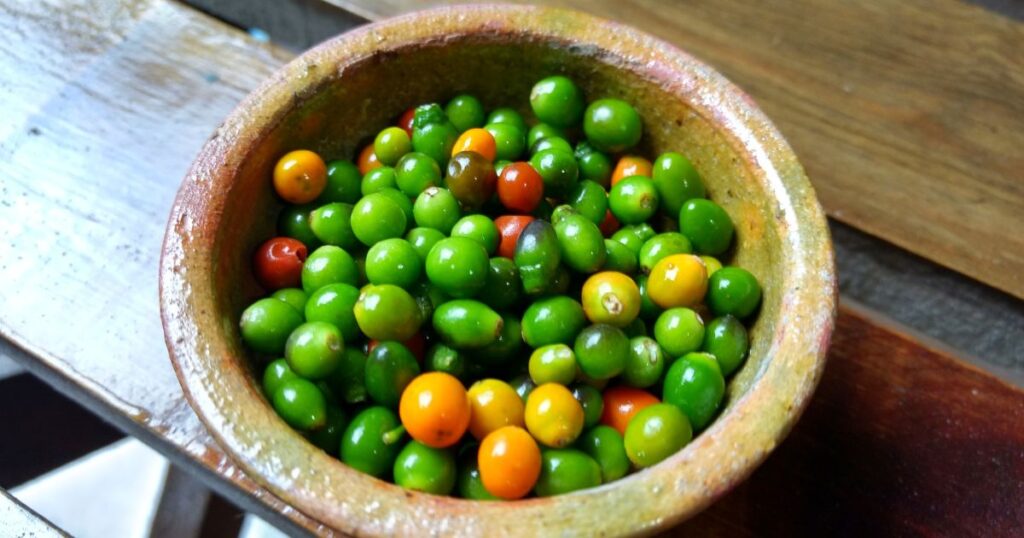
🛒 WHERE TO BUY
Where can I buy Chiltepin peppers?
Chiltepin peppers, though less widely available than other chili varieties, can be found with some searching. First, look for them at local grocery stores, particularly those that stock exotic or ethnic foods. You may also have luck finding them at specialty food stores or farmers’ markets, where local growers may have them.
When buying Chiltepin peppers, ensure they are firm with vibrant colors. Avoid any that are soft, shriveled, or have dark spots, which are signs that the peppers are past their best.
Chiltepin peppers can be purchased online in fresh and dried forms and delivered to your home. On various online retail platforms, you can also find chiltepin pepper products, such as hot sauces, powders, and cocktail mixes.
Where can I buy Chiltepin pepper plants?
Plants can be purchased from nurseries, garden centers, and online to grow Chiltepin peppers. Select one with robust stems and lush green leaves when choosing a Chiltepin pepper plant. Avoid any that appear wilted or have yellow leaves, as these are signs of poor health.
Where can I buy Chiltepin pepper seeds?
Chiltepin pepper seeds can also be procured from garden centers or online retailers for gardening enthusiasts who prefer to grow plants from seeds. Follow the planting instructions on the seed packet, ensuring a location with ample sunlight and well-drained soil for optimal growth.
🫙 HOW TO STORE
How do I store Chiltepin peppers?
Fresh Chiltepin peppers can be stored in the refrigerator, where they will keep for up to two weeks. To maximize longevity, put Chiltepin peppers in an airtight container or a sealed plastic bag, then place them in the crisper drawer of your refrigerator.
A cool, dark, and dry place away from sunlight is the optimal storage location for dried Chiltepin peppers or products like Chiltepin pepper powder or flakes. Storing them in an airtight container helps maintain their quality and keeps them free from moisture.
Can Chiltepin peppers be frozen?
Chiltepin peppers can be preserved by freezing. First, rinse the peppers and remove the stems. Then, place the peppers in a single layer on a baking sheet and freeze them for a few hours until firm. Once frozen, transfer the peppers to a freezer-safe bag or airtight container and store them in the freezer. They can be frozen for up to six months, retaining their flavor and spiciness.
❤️🩹 HEALTH BENEFITS
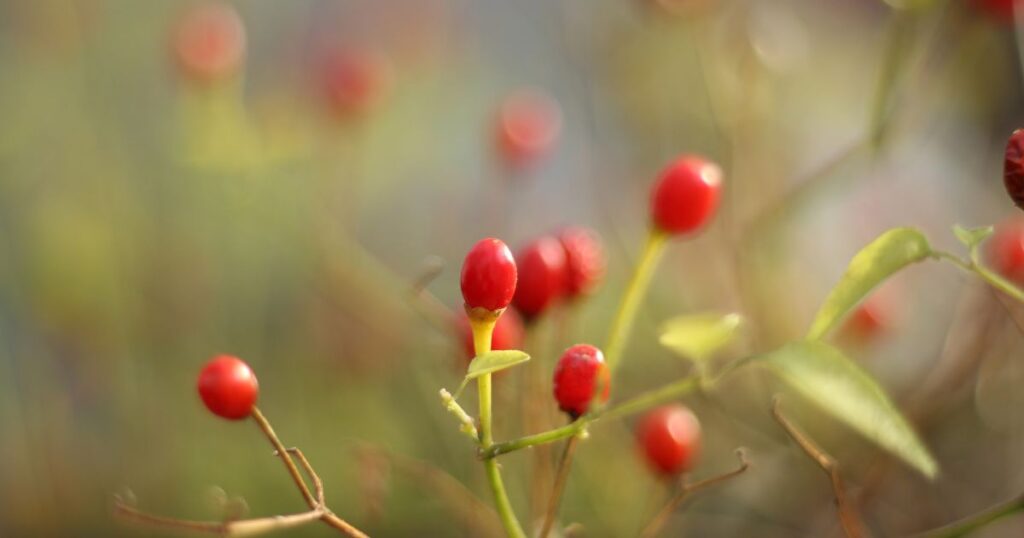
Are Chiltepin peppers healthy?
Chiltepin peppers are considered a healthy addition to your diet. They are low in calories, high in dietary fiber, and contain vitamins and minerals. These tiny, fiery peppers are particularly rich in vitamin C, which supports a healthy immune system, and vitamin A, essential for eye health and healthy skin.
Like other hot peppers, Chiltepin peppers are rich in capsaicin, which gives them their characteristic heat. Capsaicin is known for its health benefits, including anti-inflammatory properties and pain relief. Research even suggests capsaicin may support metabolic health and contribute to weight loss.
While Chiltepin peppers offer numerous health benefits, it’s important to note that their intense heat may cause discomfort for some, especially those with sensitive stomachs. As a result, consumption should be moderated according to individual tolerance.
Furthermore, due to their extreme spiciness, Chiltepin peppers are typically used sparingly in cooking, meaning their nutritional benefits may be somewhat limited by the small quantities typically consumed. However, they can contribute to a balanced, healthy diet, even in small amounts.
🔄 ALTERNATIVES AND SUBSTITUTES
What’s a good Chiltepin pepper alternative?
Finding a substitute for Chiltepin peppers can be challenging due to their unique heat and flavor, but a few alternatives exist. While habanero peppers are hotter, they can still be used as a substitute. Their heightened heat and distinct flavor can function in sauces and salsas where the fiery character of chiltepin peppers is desired.
Pequin peppers are another Chiltepin substitute. They bear a similar heat and a somewhat fruity flavor. As a result, they work well in various dishes, including sauces, stews, and rubs.
For those seeking less spiciness, Serrano peppers are a suitable choice. They offer a milder heat and can be used in various dishes, including sauces, soups, and salsa, while providing a kick.
Finally, jalapeño peppers offer a widely available, milder option for those who prefer less heat. They are versatile and can be used in various recipes. Remember that the seeds and membranes can be removed to temper the spice further. Additionally, Jalapeños provide a delicate spiciness that doesn’t dominate dishes, making them a substitute for those with lower heat tolerance.
How do you pronounce Chiltepin pepper?
Chiltepin pepper is pronounced as chill-TEH-pin PEH-per.
🙋 FREQUENTLY ASKED QUESTIONS
FAQ about chiltepin peppers
Are Chiltepin peppers hot?
Yes, Chiltepin peppers are hot. These small but mighty peppers pack a significant punch, falling between 50,000-100,000 Scoville Heat Units (SHU) on the Scoville scale. Their heat is described as swift and intense, with a fiery sensation that takes you by surprise. Despite their size, these peppers should be used sparingly, especially for those unfamiliar with spicy foods.
Why is Chiltepin so expensive?
The cost of Chiltepin peppers can be attributed to several factors. First, these peppers are wild and typically hand-harvested, which increases the labor cost. They are also less widely cultivated than other peppers, reducing their supply. Additionally, their intense heat and unique flavor have gained them a special place in the world of chili peppers, further driving demand and hence their price.
What’s the difference between Chiltepin pepper and Pequin?
Chiltepin and Pequin peppers are often confused due to their similar size and heat. However, they have distinct characteristics. Chiltepin peppers are small, round, and grow in the wild. They pack intense heat that hits quickly but fades fast. On the other hand, Pequin peppers are oval-shaped and possess a smoky flavor with fruity and citrusy undertones. While they also deliver a strong but slightly lesser kick, their heat lingers longer than Chiltepins.
What’s the difference between Chiltepin pepper and Habanero?
Chiltepin and Habanero peppers differ in various ways, including their size, shape, heat level, and flavor. Chiltepin peppers are tiny and round with a swift, intense heat. Habaneros are larger and lantern-shaped; while they're significantly hotter, their heat builds gradually and lingers. In terms of flavor, Chiltepin peppers have a nutty, earthy taste, while Habaneros offer a fruity and floral flavor.
What’s the difference between Chiltepin pepper and Carolina Reaper?
Chiltepin and Carolina Reaper peppers are starkly different in heat level. The Carolina Reaper, recognized as one of the world's hottest peppers, reaches over 2,000,000 SHU on the Scoville scale. In contrast, Chiltepins range from 50,000 to 100,000 SHU. Aside from their heat, these two peppers also differ in size, with the Chiltepin being small and round, while the Carolina Reaper is larger with a unique 'tail.
